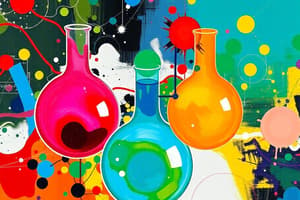Podcast
Questions and Answers
In which state of matter will the atoms of an element be tightly packed together?
In which state of matter will the atoms of an element be tightly packed together?
- Liquid
- Gas
- Solid (correct)
A piece of paper burns, producing heat and light. Which best describes the process of burning?
A piece of paper burns, producing heat and light. Which best describes the process of burning?
- Burning is a chemical change. The paper breaks down in sunlight, producing heat and light.
- Burning is a chemical change. The paper reacts with the oxygen in the air, producing heat and light. (correct)
- Burning is a physical change. The paper mixes with the oxygen in the air, producing heat and light.
- Burning is a physical change. The paper changes from a solid to a gas, producing heat and light.
A chemical change happens when:
A chemical change happens when:
- Electricity flows through a wire
- Ice cream melts into a liquid
- Glass breaks into pieces
- Dough bakes in an oven (correct)
Which best describes the solid that forms when two liquids combine in a chemical reaction?
Which best describes the solid that forms when two liquids combine in a chemical reaction?
In a chemical reaction, what is the best description of a molecule's movement when the temperature decreases?
In a chemical reaction, what is the best description of a molecule's movement when the temperature decreases?
An artist carves a statue by chipping off pieces from a marble slab. Which of these is the BEST reason to describe the carving as a physical change?
An artist carves a statue by chipping off pieces from a marble slab. Which of these is the BEST reason to describe the carving as a physical change?
Liquids placed in a beaker will settle in specific layers. Which physical property of matter does this illustrate?
Liquids placed in a beaker will settle in specific layers. Which physical property of matter does this illustrate?
Which best represents a physical change?
Which best represents a physical change?
A chemistry student combines 32 grams of one chemical and an unknown amount of another chemical in a closed system. A chemical reaction occurs and the mass of the products is 114 grams. How much of the unknown chemical was used in the reaction?
A chemistry student combines 32 grams of one chemical and an unknown amount of another chemical in a closed system. A chemical reaction occurs and the mass of the products is 114 grams. How much of the unknown chemical was used in the reaction?
Which best demonstrates a physical change?
Which best demonstrates a physical change?
Which statement BEST describes the change to an ice cube as it melts?
Which statement BEST describes the change to an ice cube as it melts?
Which demonstrates a chemical change?
Which demonstrates a chemical change?
When two liquids are mixed together, a solid forms and settles on the bottom of the container. What can be concluded?
When two liquids are mixed together, a solid forms and settles on the bottom of the container. What can be concluded?
A chemical reaction separates water into hydrogen gas and oxygen gas. Which of the following statements is true about the mass of the water and the combined mass of the two gases?
A chemical reaction separates water into hydrogen gas and oxygen gas. Which of the following statements is true about the mass of the water and the combined mass of the two gases?
Which is true of mass during a chemical reaction?
Which is true of mass during a chemical reaction?
What best explains the result of substances of a chemical reaction?
What best explains the result of substances of a chemical reaction?
Flashcards are hidden until you start studying
Study Notes
States of Matter
- Atoms of an element are tightly packed together in a solid state.
Chemical Changes
- Burning paper is a chemical change as it reacts with oxygen, producing heat and light.
- Baking dough results in a chemical change due to the transformation of ingredients.
Precipitation
- The solid that forms when two liquids undergo a chemical reaction is called a precipitate.
Molecular Movement
- In a chemical reaction, molecular movement decreases as temperature decreases.
Physical Changes
- Carving a statue from a marble slab is a physical change since the substance remains the same.
- Liquids in a beaker settling in layers illustrates the property of density.
- Condensation best represents a physical change among the provided options.
- A change in state also exemplifies a physical change.
Mass and Chemical Reactions
- In a closed system, if 32 grams of one chemical combines with an unknown amount, and the total mass is 114 grams, then 82 grams of the unknown chemical was used.
- The mass of water before separation into gases remains equal to the combined mass of hydrogen and oxygen gases afterward.
- Mass remains unchanged during a chemical reaction.
New Substances
- A chemical reaction results in the production of a new substance, distinguishing it from physical changes.
Studying That Suits You
Use AI to generate personalized quizzes and flashcards to suit your learning preferences.




